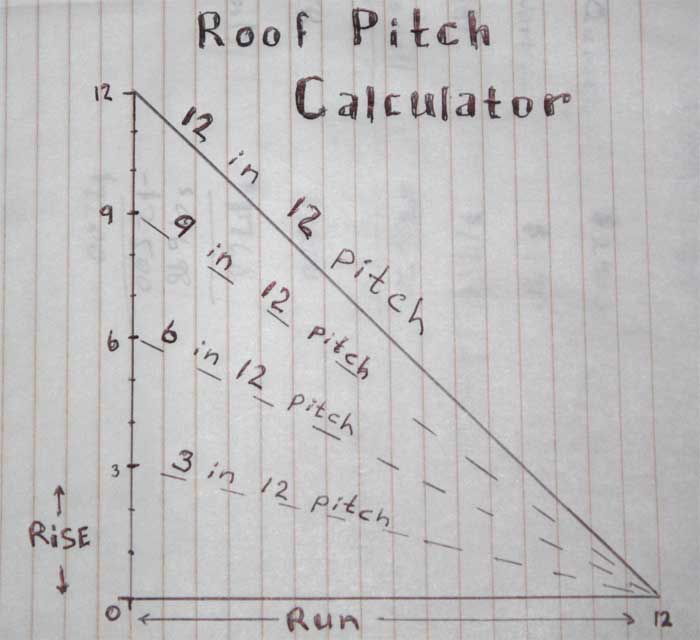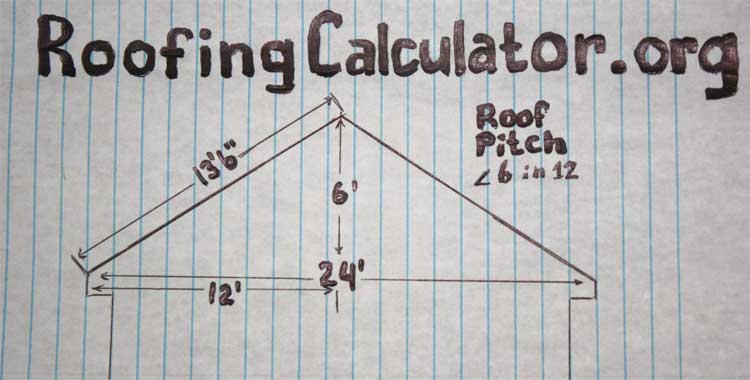This is part 2 of our Roof Pitch guide. In the first part, we’ve reviewed what roof pitch is and how you can use it to measure and estimate roof size and replacement cost.
Roof pitch is essentially a measurement of roof slope / roof steepness, and is used by US and Canadian Roofing contractors when measuring roofs.
Check out these two helpful guides, that can be of interest to roofers and homeowners alike:
How to calculate roof pitch using level and a tape measure:

To get the roof slope with a level, you will need to get up on the roof, or working of a ladder, place one end of the level so it touches the roof, and the other end is in the air, away from the roof surface. Make sure it is leveled horizontally. Now measure the distance between the level’s end which is in the air, and the roof bellow it, placing a tape measure straight down, until it touches the roof.
Let’s say the distance you get using the tape measure, between level and roof is 12 inches, and your level is 2 feet. Your roof pitch will be 12 in 24 or 6 in 12 (divide both numbers by to, to get to the 12″ base run). If you get 10″ rise in 24″ run, then your roof pitch is 5 in 12 or simply 5, and so on.

Calculating roof pitch without using the level:
You don’t always need a level to calculate the roof pitch, though with level, you will produce the most accurate roof pitch measurements. To calculate the roof slope, you will need the width measurements of the Gable End of your roof, and the drop from roof ridge or peak to the roof base. This is where the simple geometry and math can be applied to get pretty accurate roof pitch measurements.
You can get up on the ladder, and measure the distance between roof peak and roof base. Then divide roof base in half (by 2) and this will give you the roof run – using these numbers you will be able to calculate roof pitch. For example if your roof base is 24 feet, then 1/2 or run of your roof is 12 feet. If your rise measured to be 7 feet then your roof pitch or roof slope is 7 in 12 or simply 7.

If you get odd numbers for the run(which is often the case – you rarely get a 24′ wide gable ends on the house) – lets say your roof base is 30′ and hence the roof run is 15′, while roof rise is still 7, then your roof slope is 7 in 15? Yes it is, but you still want to bring it to the 12″ base numbers, so that you could use roof slope multipliers when calculating roof sizes.
To bring these numbers to 12″ base, you divide both numbers by 15 and multiply them by 12.
You can also just calculate the number of siding panels and multiply this number by the siding “exposure”. Average clap-board siding has 4″ exposure, so 3 rows of clapboard siding will give you 1 foot, and 9 rows will give you 3 feet.
Calculating roof run without using roof pitch or pitch multipliers:
You can measure the sloped run of your roof (gable / rakes) without using the itch multiples, and often get a slightly more accurate measurement. Roof pitch multipliers are there to simplify the job, but since they are rounded numbers, they are not 100% accurate. You can use the Pythagorean theorem (which is used to calculate roof pitch multipliers) to calculate the run of your sloped roof.
To measure the gable run, you need to look at your roof from the side and picture it as a triangle, with one unknown – refer to the roof diagram above. You already have the measurements of your base and your rise (bisector). To calculate the longer, unknown side of the triangle, you need to add the square of the base and square of the rise / bisector, and take a square roof of the sum, or A2 + B2 = C2.
For example you have a base of 12 and a rise of 6, and you need to know the 3rd side. You add 144 (12 square) and 36 (6 square) and take the square root of the sum, which is about 13.5 – the length of the unknown side.
Afterword:
Now that you know how to measure roof pitch, you can apply it, and get very accurate roof measurements without having to climb the roof. You can also use roof pitch to estimate roofing prices, and understand how our roofing calculator works. This roof pitch guide is a second part of a three part series on measuring and estimating roofs. In the first part, we explain how to measure simple roofs, using tape measure, and applying the roof pitch multiplier. In the third part, we will teach you how to measure complicated roofs and estimate roofing costs / prices – a roof estimating guide for roofing contractors and estimators.
|
Low End
$4837
Mid Range
$6046
High End
$7558
|
|
|

 See costs in your area
See costs in your area